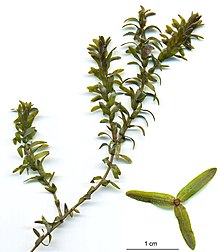Elodea canadensis
| Elodea canadensis | |
|---|---|
 |
|
| Scientific classification | |
| Kingdom: | Plantae |
| (unranked): | Angiosperms |
| (unranked): | Monocots |
| Order: | Alismatales |
| Family: | Hydrocharitaceae |
| Genus: | Elodea |
| Species: | E. canadensis |
| Binomial name | |
|
Elodea canadensis Michx. |
|
| Synonyms | |
|
|
Elodea canadensis (American or Canadian Waterweed or Pondweed) is a perennial aquatic plant, or submergent macrophyte, native to most of North America. It has been introduced widely to regions outside its native range and was first recorded from the British Isles in about 1836.
Native to most of North America. Widely introduced to regions outside its native range such as Ireland and the British Isles (female plants only).
Ireland: County Galway found at several sites along the Eglinton Canal, County Galway County Down. and from the Lagan Canal near Lisburn, Ireland.
Young plants initially start with a seedling stem with roots growing in mud at the bottom of the water; further adventitious roots are produced at intervals along the stem, which may hang free in the water or anchor into the bottom. It grows indefinitely at the stem tips, and single specimens may reach lengths of 3 m or more.
The leaves are bright green, translucent, oblong, 6–17 mm long and 1–4 mm broad, borne in whorls of three (rarely two or four) round the stem. It lives entirely underwater, the only exception being the small white or pale purple flowers which float at the surface and are attached to the plant by delicate stalks.
It is dioecious, with male and female flowers on different plants. The flowers have three small white petals; male flowers have 4.5–5 mm petals and nine stamens, female flowers have 2–3 mm petals and three fused carpels. The fruit is an ovoid capsule, about 6 mm long containing several seeds that ripen underwater. The seeds are 4–5 mm long, fusiform, glabrous (round), and narrowly cylindrical. It flowers from May to October.
It grows rapidly in favorable conditions and can choke shallow ponds, canals, and the margins of some slow-flowing rivers. It requires summer water temperatures of 10–25 °C and moderate to bright lighting.
...
Wikipedia
